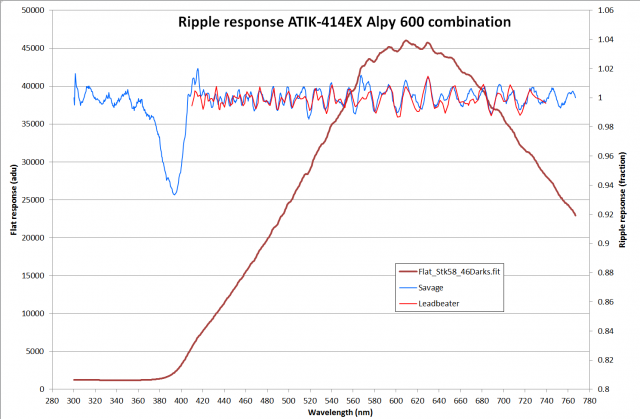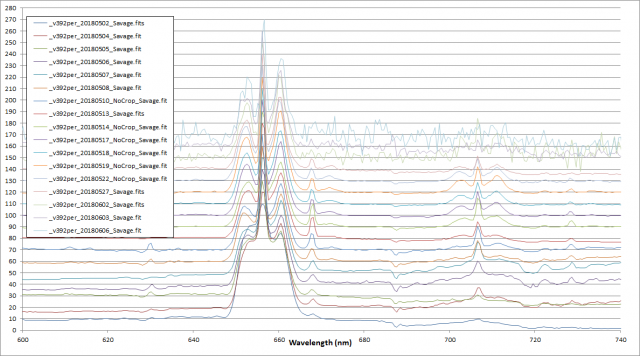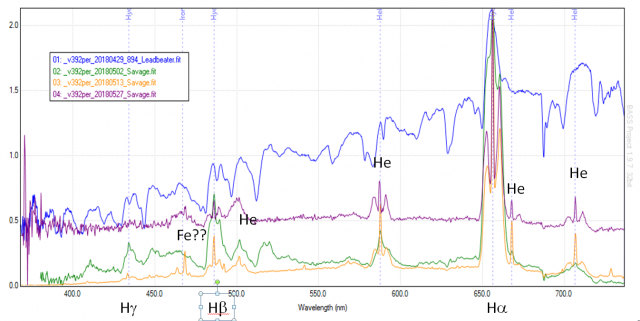Forum Replies Created
-
AuthorPosts
-
 John SavageParticipant
John SavageParticipantFirstly, Tony, are you AJV who posted this issue to the ZWO forum in 2021-Jun-17? There doesn’t seem to be an answer from ZWO.
Becoming aware of this thread, I tested my own setup using ASIImg V1.7 (64bit) and both a ASI16200MM and a ASI174MM camera. For both cases the DATE-OBS header has the end time (or within a second or two of it) NOT the start time. This is despite the comment on the DATE-OBS entry which says “/ UTC start date of observation”.
I will also make my own posting on the ZWO forum about this. Unimpressed with ZWO on this.
 John SavageParticipant
John SavageParticipantHi Robin,
Here is the ripple response of my camera compared with your ATIK-414. (I digitised values from your image, so there are picking errors.) In the overlap range, 420-730 nm I get a slightly higher standard deviation (0.59%) than yours, but the correspondence is gratifying.

Again, thanks for putting me straight on this.
Cheers, John
 John SavageParticipant
John SavageParticipantRobin,
Interesting. Thanks for alerting me to this. I had always assumed that the spectral responses of these detectors was smooth. I will try to get the ripple response determined for my camera.
Cheers,
John
 John SavageParticipant
John SavageParticipantFirstly again thanks for all the above.
My contributions above were all made without flats to keep it simple to start with. But Andy (and I note Robin’s comments above too) said I must use flats if I wanted to contribute to the BAA spectral Database. Having now got to grips application of flats, I recognise that this is important and it will be a standard part of my routine.
In viewing the flats, I note the ripple on the image. The ripples are parallel to the slit direction which indicates to me that the majority of the effect is in the spectroscope rather than the camera. I also see thinner striations perpendicular which I reckon are due to imperfections or dust in the slit. Anyway – these factors do need to be corrected for.
Eye-balling the ripples, I would say there is quite strong wavelength periodicity. I suggest that this is due to imperfection in the grating – maybe edge effects where one grating line meets another and mostly the same at each interface, so periodic. Manufacturing gratings with the blazing as good as it appears to be must be quite an engineering feat. When I get time, I’d like to try and model these effects.
Cheers,
John
 John SavageParticipant
John SavageParticipantHi Nick, Andy,
I should log on more often!
My last attempt with V392 Per was on 6th – very dim and almost swallowed in twilight. Low altitude meant that I had nearly 50% of the ‘scope’s aperture obstructed by the bottom of the shutter of my observatory too. I feel fortunate that I got any kind of image as I could only detect the faintest ghost in the guide camera image and it was more luck than judgement getting any light from this object through the slit. Only the Ha complex was detectable, but it is and here is the result, alongside the rest in an Excel normalised stack.

Andy, Thanks for the tip about verifying response curves. I need to work at this aspect a bit more. I’m sure I am not getting atmospheric bands out well – the BASS method of picking and spline fitting to smooth an initial response curve doesn’t get the detail of these for me (and tends to become unstable when I try).
The above graph is normalised and plotted so that the pedestals either side of the Ha peak are 10 units apart and the Ha central peak is 100 units relative to the pedestals. It seemed easier to do this in Excel than in BASS, but I don’t end up with a set of spectra I can submit. I need to get to grips with the BASS way of doing this (I think I understand the basics of how to do it). Indeed one of my next tasks is to read up about preparing spectra for submission to e.g. the BAA database.
Cheers,
John Savage
 John SavageParticipant
John SavageParticipantfor this further wealth of information. Plenty to digest!
 John SavageParticipant
John SavageParticipantNews of this nova reached me only a day after I had obtained my first stellar spectra with my new Alpy 600. As this object might show interesting developments as time went on, I thought I would obtain spectra on every observable night I obtained spectra on 14 nights (“evenings” more like) from 2018-05-02 to 2018-05-27.
I have been collecting data at a much greater rate than I could process it – as I was climbing up the processing curve as well as dealing with some acquisition issues, guiding especially. Thanks to Andy Wilson for his tutorial on BASS which I have used for this processing and also to Robin for tips and information.
But now I have processed spectra for three of the 14 dates (May-05, -13 and -27) and I am pleased with them. Here are the profiles, with Robin Leadbeater’s for comparison – and 1D fits files are attached too.

I am not sure I have the instrument response correction right, but I am pleased with the sharpness of the lines and to see that most of the lines are triplicated i.e with most of the prominent lines having two “side lobes”. I hope I have identified the He lines correctly – I am suspicious about the Fe line (which BASS reports).
I have read practically nothing about the spectra of novae as yet, but I see these as being blue and red-shifted versions of the central line, which conjures up the image of an accretion disk with material on either side approaching us and receding. If this is the case and if I have my sums correctly, the velocities are some 1,000-2,000 km/s, with the approaching material tending to be slower. Can this be correct? Also, it seems to me that these have developed with time – the side lobes aren’t prominent in Robin’s very early spectrum, nor of mine, 3 days later (2018-05-02). By 2018-05-13 they are well developed (easily visible on the raw images too).
These are hot off the press, and I would welcome feedback on the results – e.g. should I be concerned about the instrument response correction? I will be tackling the other 11 night’s spectra in the coming days. Eventually I will be subjecting the whole lot to a more detailed analysis and, before getting too far advanced, I’d appreciate hearing opinions about the accretion disk (novae are supposed to have them, I read) hypothesis and whether radial velocities really can be as high as I suggest. In fact I’d be grateful for a pointer to a primer on the spectra of novae and any early papers/comments on this one.
Thanks, John
 John SavageParticipant
John SavageParticipantHi Robin,
Thanks for your comments, tips and wealth of information. And sorry for being a bit tardy with an acknowledgement.
I have been busy developing a utility to blend images of stellar and calibration lamp spectra. Using this I found that I couldn’t get consistent polynomial fits simultaneously to both stellar absorption lines and calibration emission lines, especially if the ‘scope had been moved in between. This pointed to a flexure problem. I was dismayed to find I hadn’t tightened all six of the Alpy thumbscrews properly. I should have checked this much earlier!
Now to look again at focusing for the blue end of the calibration line spectrum.
Best wishes,
John
 John SavageParticipant
John SavageParticipantAndy,
Many thanks for the tips. I’ve downloaded your pdf tutorial – it looks to be excellent – just what I need and I look forward to going through it in detail, probably starting with section 5.
Best wishes,
John
-
AuthorPosts
